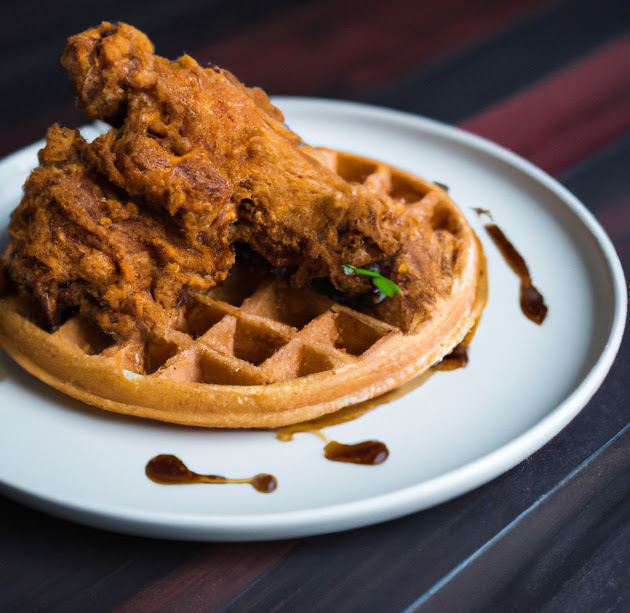Midnight Chicken & Waffles – Inspired by Edward Hopper’s “Nighthawks”
Recipe: Midnight Chicken and Waffles with Maple-Bourbon Glaze
Ingredients:
- 4 Chicken Breasts or 8 Chicken Tenders
- 2 cups Buttermilk
- 2 cups All-purpose Flour
- 2 tsp Baking Powder
- 2 tsp Salt
- 1/2 tsp Black Pepper
- 2 tsp Paprika
- 2 tsp Garlic Powder
- Oil for frying
- 2 cups Waffle Batter
- 1/4 cup Maple Syrup
- 1/4 cup Bourbon
Instructions
- Marinate the chicken in buttermilk, 1 tsp garlic powder, 1 tsp salt and 1 tsp paprika for at least 30 minutes (or up to 24 hours in the refrigerator)
- In a shallow dish, mix the flour, baking powder, the 1 tsp salt, 1 tsp garlic powder, 1/2 tsp pepper, and 1 tsp paprika.
- Heat about 2 inches of oil in a deep fryer or heavy-bottomed pan to 350°F (175°C).
- Remove the chicken from the buttermilk and allow the excess to drip off. Dredge each piece in the flour mixture, ensuring it is fully coated.
- Fry the chicken in batches until golden brown and cooked through, about 6-8 minutes for tenders or 10-12 minutes for breasts. Remove and drain on paper towels.
- Preheat your waffle iron and prepare waffles using
your favorite waffle recipe or a store-bought mix. Bake the waffles
until golden.
- In a small saucepan, combine the maple syrup and bourbon. Bring to a simmer and cook for 5-7 minutes, or until slightly thickened.
- Plate the waffles, place the fried chicken on top, and drizzle with the maple-bourbon glaze.
Interesting
A theory of the origin of the recipe suggests, that chicken and waffles originated in the 1600s with the arrival of German settlers, known as the Pennsylvania Dutch, in the United States. The Pennsylvania Dutch were known for their hearty, filling meals, and they often paired waffles with a savory component. One popular combination was waffles served with pulled or stewed chicken and gravy. This version of the dish bears a closer resemblance to what we know today as chicken and waffles.
The second theory points to the American South as the birthplace of the dish. In the late 19th and early 20th centuries, African American cooks in the South began to combine fried chicken and waffles, often served with syrup. This version of the dish gained popularity during the Harlem Renaissance in the 1920s and 1930s when late-night diners and jazz clubs began offering the dish as a late supper or early breakfast option.
Edward Hopper: Nighthawks
 |
| Edward Hopper, Nighthawks |
"Nighthawks" is an iconic oil painting created by Edward Hopper in 1942. It depicts an urban scene of a late-night diner with large glass windows, which allow viewers to peer into the illuminated space. The painting is characterized by its strong use of contrast, with the brightly lit interior of the diner standing out against the dark, almost desolate, nighttime street.
The painting is renowned for its evocative atmosphere and sense of isolation. The empty street and the lack of interaction among the characters contribute to a feeling of loneliness and detachment. The painting also captures the quintessential American urban experience, making "Nighthawks" one of Edward Hopper's most famous and enduring works.
Edward Hopper
Edward Hopper (1882-1967) was an American realist painter and printmaker, widely recognized for his evocative portrayal of American life, particularly in urban settings. Hopper was born in Nyack, New York, and studied at the New York School of Art under influential artists and teachers such as William Merritt Chase and Robert Henri.
Hopper's artistic style is characterized by his use of light and shadow, subdued color palettes, and minimal, often solitary figures. He had a unique ability to capture the essence of a scene or mood with simplicity and clarity. His work is often described as a visual expression of the feelings of loneliness, isolation, and introspection that many people experience in modern society.









Comments
Post a Comment